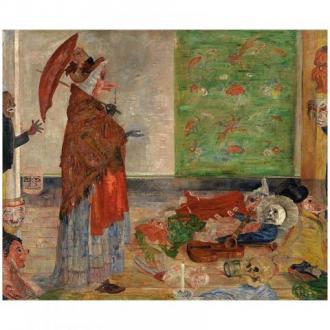This archived website ‘James Ensor. An online museum.’ is temporarily not being updated. Certain functionality (e.g. specific searches in the collection) may no longer be available. News updates about James Ensor will appear on vlaamsekunstcollectie.be. Questions about this website? Please contact us at info@vlaamsekunstcollectie.be.
Ensor in The Hague
Alhough now that the Ensor Year is behind us, the Ostend painter remains prominently on the scene. After major exhibitions in the MoMA in New York, the Musée d'Orsay in Paris and the ING Cultural Centre in Brussels, another significant exhibition of the Belgian artist now comes to Holland. From 12 March until 13 June, the ‘Universe of a Dreamer' expo can be seen in the Gemeentemuseum Den Haag. Just as in Paris, New York and Brussels, the Royal Museum of Fine Arts Antwerp (KMSKA) is the main provider of works on loan. This exhibition enjoys support from the Flemish Government.
The Hague strives to present an overview of Ensor's career. It deals with his satirical world vision, takes a look at his exceptional gifts, and gives attention to the pioneering role that Ensor assumed. Just as ‘Ensor Unmasked' (ING-Culture Centre, Brussels 2010) zoomed in on the important realistic, early years of the painter, this will also not be passed over in The Hague.
An original departure point for the ‘Universe of a Dreamer' is the emphasis on Ensor's connection with Holland. Rembrandt van Rijn (1606-1669), for example, was always a major inspiration for Ensor. The Ostend painter traveled at a young age through the country and was inspired by the old Dutch Masters. In The Oyster-eater (1882) from the KMSKA, we see characteristics of still lifes from the Dutch Golden Century.
Ensor's work was already well received in Holland and even exhibited and collected. Likewise, in 1895 he had a showing in The Hague. Moreover, Ensor had a good relationship with painter Jan Toorop. They were two men with one expressed personality. It was the time in which both broke through with a crucial artistic development. In the exhibition then, the work of this artist is also taken into consideration, along with a small selection of French and Dutch colleagues Vingtisten (Monet, Seurat and van Gogh) from the collection of the Gemeentemuseum.
Ensor's popularity in Europe and in the rest of the world is clearly on the rise. That is not surprising since his bizarre universe of grotesque characters, Chinoiseries and masks was influenced by various cultures such as Japanese No masks and Italian commedia dell'arte. Ensor, moreover, is a pioneer in diverse European movements as Expressionism, Symbolism and Surrealism. He holds an honorary place in the canon of modern art and belongs among the elite of European art.
The KMSKA possesses the largest Ensor collection in the world. It is possible that a portion of the collection will travel on to four locations in Japan in 2012. A richly illustrated publication with contributions from Saskia de Bodt, Herwig Todts and Doede Hademan appears in conjunction with this exhibition.
Date: From 12 March until 13 June, 2011
Where: The Gemeentemuseum Den Haag
More info: http://www.gemeentemuseum.nl







